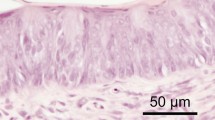Summary
A mechanosensitive ciliated cell type of the polyp Stauridiosarsia producta (Hydrozoa) was investigated by means of electron microscopy. These cells bear at their apical cell surface a modified cilium, a set of seven stereovilli, a so-called pseudovillar system and a large vacuole. Cilium and stereovilli are interconnected like the cnidocil apparatus of hydrozoan nematocytes which is responsible for mechanoelectric transduction. The vacuole is enclosed by and linked to the pseudovillar system by a microtubular basket. Considering its structural organization and physiological activities the ciliated sensory cell closely resembles a nematocyte that has lost its ability ot produce a nematocyst.
Similar content being viewed by others
References
Brinkmann M, Thurm U (1993) Mechanoreceptive properties of hydrozoan nematocytes in situ. In: Elsner N, Heisenberg M (eds) Proc 21st Göttingen neurobiol conf. Thieme, Stuttgart, p 155
Brinkmann M, Golz R, Thurm U (1994) Determination of the site of mechanoelectrical transduction in the nematocytes of Stauridiosarsia by combined electrophysiological and ultrastructural investigations. Elsner N, Breer H (eds) Proc 22nd Göttingen neurobiol conf. Thieme, Stuttgart, p 67
Budelmann BU (1989) Hydrodynamic receptor systems in invertebrates. In: Coombs S, Görner P, Münz H (eds) The mechanosensory lateral line. Neurobiology and evolution. Springer, New York, pp 607–631
Cormier SM, Hessinger DA (1980) Cnidocil apparatus: Sensory receptor of Physalia nematocytes. J Ultrastruct Res 72:13–19
Golz R (1994) Occurrence and distribution of RFamide-positive neurons within the polyps of Coryne sp. (Hydrozoa, Corynidae). Biol Bull 186:115–123
Golz R, Thurm U (1991a) Cytoskeletal modifications of the sensorimotor-interneurons of Hydra vulgaris (Cnidaria, Hydrozoa), indicating a sensory function similar to chordotonal receptors of insects. Zoomorphology 111:113–118
Golz R, Thurm U (1991b) Cytoskeleton-membrane interactions in the cnidocil complex of hydrozoan nematocytes. Cell Tissue Res 263:573–583
Golz R, Thurm U (1993) Ultrastructural evidence for the occurrence of three types of mechanosensitive cells in the tentacles of the cubozoan polyp Carybdea marsupialis. Protoplasma 173:13–22
Hausmann K, Holstein T (1985) Bilateral symmetry in the cnidocil-nematocyst complex of the freshwater medusa Craspedacusta sowerbii Lankester (Hydrozoa, Limnomedusae). J Ultrastruct Res 90:89–104
Holstein T (1981) The morphogenesis of nematocytes in Hydra and Forskalia: An ultrastructural study. J Ultrastruct Res 75:276–290
Holstein T, Hausmann K (1988) The cnidocil apparatus of hydrozoans: A progenitor of higher metazoan mechanoreceptors? In: Hessinger DA, Lenhoff HM (eds) The biology of nematocysts. Academic Press, San Diego, pp 53–73
Holstein T, Tardent P (1984) An ultrashigh-speed analysis of exocytosis: Nematocyst discharge. Science 223:830–833
Koizumi O, Wilson JD, Grimmelikhuijzen CJP, Westfall JA (1989) Ultrastructural localization of RFamide-like peptides in neuronal dense-cored vesicles in the peduncle of Hydra. J Exp Zool 249:17–22
Mariscal RN (1974) Nematocysts. In: Muscatine L, Lenhoff HM (eds) Coelenterate biology. Academic Press, New York, pp 129–178
Slautterback DB (1967) The cnidoblastmusculo-epithelial cell complex in the tentacles of Hydra. Z Zellforsch 79:296–318
Stidwill RP, Honegger TG (1989) A single layer of microtubules is part of a complex cytoskeleton in mature nematocytes of Hydra. Tissue Cell 21:179–188
Stoessel F, Tardent P (1971) Die Reaktionsmuster von Coryne pintneri und Sarsia reesi (Athecata: Capitata) auf Berührungsreize. Rev Suisse Zool 78:689–697
Tardent P, Holstein T (1982) Morphology and morphodynamics of the stenotele nematocyst of Hydra attenuata Pall. (Hydrozoa, Cnidaria). Cell Tissue Res 224:269–290
Tardent P, Schmid V (1972) Ultrastructure of mechanoreceptors of the polyp Coryne pintneri (Hydrozoa, Athecata). Exp Cell Res 72:265–275
Weber J (1989) Nematocysts (stinging capsules of cnidaria) as Donnan-potential-dominated osmotic systems. Eur J Biochem 184:465–476
Westfall JA (1973) Ultrastructural evidence for a granule-containing sensory-motor-interneuron in Hydra littoralis. J Ultrastruct Res 42:268–282
Westfall JA (1988) Presumed neuronematocyte synapses and possible pathways controlling discharge of a battery of nematocysts in Hydra. In: Hessinger DA, Lenhoff HM (eds) The biology of nematocysts. Academic Press, San Diego, pp 41–51
Wood RL, Novak PL (1982) The anchoring of nematocysts and nematocytes in the tentacles of Hydra. J Ultrastruct Res 81:104–116
Author information
Authors and Affiliations
Rights and permissions
About this article
Cite this article
Golz, R., Thurm, U. The ciliated sensory cell of Stauridiosarsia producta (Cnidaria, Hydrozoa) — a nematocyst-free nematocyte?. Zoomorphology 114, 185–194 (1994). https://doi.org/10.1007/BF00403266
Accepted:
Issue Date:
DOI: https://doi.org/10.1007/BF00403266




